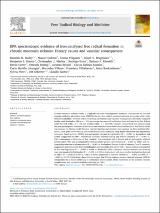EPR spectroscopic evidence of iron-catalysed free radical formation in chronic mountain sickness : dietary causes and vascualr consequences
Fecha
2022Autor
Bailey, Damian M
Culcasi, Marcel
Filipponi, Teresa
Brugniaux, Julien V
Stacy, Benjamin S
Marley, Chistopher J
Soria, Rodrigo
Rimoldi, Stefano F
Cerny, David
Rexhaj, Emrush
Pratali, Lorenza
Salinas Salmón, Carlos
Murillo Jáuregui, Carla
Villena, Mercedes
Villafuerte, Francisco
Rockenbauer, Antal
Pietri, Sylvia
Scherrer, Urs
Sartori, Claudio
Metadatos
Mostrar el registro completo del ítemResumen
Abstract
Chronic mountain sickness (CMS) is a high-altitude (HA) maladaptation syndrome characterised by elevated systemic oxidative-nitrosative stress (OXNOS) due to a free radical-mediated reduction in vascular nitric oxide (NO) bioavailability. To better define underlying mechanisms and vascular consequences, this study compared healthy male lowlanders (80 m, n = 10) against age/sex-matched highlanders born and bred in La Paz, Bolivia (3600 m) with (CMS+, n = 10) and without (CMS-, n = 10) CMS. Cephalic venous blood was assayed using electron paramagnetic resonance spectroscopy and reductive ozone-based chemiluminescence. Nutritional intake was assessed via dietary recall. Systemic vascular function and structure were assessed via flow-mediated dilatation, aortic pulse wave velocity and carotid intima-media thickness using duplex ultrasound and applanation tonometry. Basal systemic OXNOS was permanently elevated in highlanders (P = <0.001 vs. lowlanders) and further exaggerated in CMS+, reflected by increased hydroxyl radical spin adduct formation (P = <0.001 vs. CMS-) subsequent to liberation of free ‘catalytic’ iron consistent with a Fenton and/or nucleophilic addition mechanism(s). This was accompanied by elevated global protein carbonylation (P = 0.046 vs. CMS-) and corresponding reduction in plasma nitrite (P = <0.001 vs. lowlanders). Dietary intake of vitamins C and E, carotene, magnesium and retinol were lower in highlanders and especially deficient in CMS + due to reduced consumption of fruit and vegetables (P = <0.001 to 0.028 vs. lowlanders/CMS-). Systemic vascular function and structure were also impaired in highlanders (P = <0.001 to 0.040 vs. lowlanders) with more marked dysfunction observed in CMS+ (P = 0.035 to 0.043 vs. CMS-) in direct proportion to systemic OXNOS (r = −0.692 to 0.595, P = <0.001 to 0.045). Collectively, these findings suggest that lifelong exposure to iron-catalysed systemic OXNOS, compounded by a dietary deficiency of antioxidant micronutrients, likely contributes to the systemic vascular complications and increased morbidity/mortality in CMS+.

